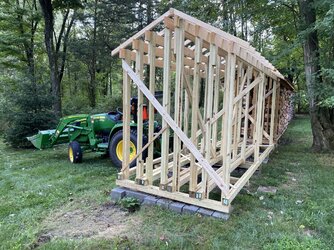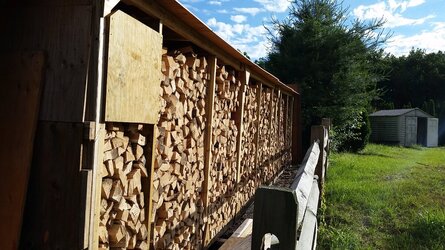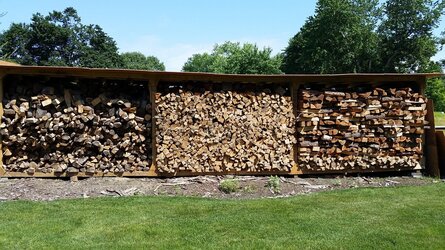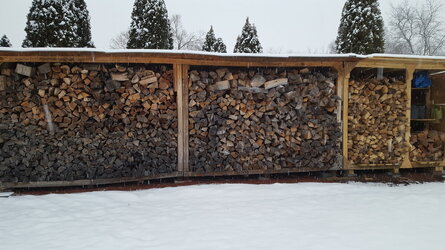I have four of these wood racks right now, each 4 cords, and a fifth that's only 1 cord. I call them "racks", because I designed them to be a scant 4 sq.ft. under my township's threshold for requiring a shed permit, and thus dealing with setback variances in their chosen location. Each is set on a foundation of dry-stacked concrete block, leveled with the aid of a little quickcrete or mortar (whichever I happened to have on-hand when placing each shed), and I can easily pick one up and move it with my tractor. They weigh about 3000 lb. when built, so size your tractor accordingly, although they probably lose nearly half that weight in their first year, as the pressure treated lumber dries. The last one went into a more precarious than usual spot, so I moved it before installing the roof, which made lifting and moving it much safer, but then meant I had to do the roofing work away from my shop and tools.
I can't say enough good things about this setup, I have them placed in a neat row, so I can just pull my wagon down the line to the shed from which I'll be pulling wood. Not having to walk into a deep wood shed was one of my criteria, as I was using nearly 10 cords of wood per year, and always short on time to move it.
But one down-side to this setup is its low efficiency storage. Four "racks" is only 16 cords, which really isn't very much wood. To store the ~30 cords I used to always keep on hand, I'd need 7 of these sheds. Cost to build used to run me $1k, but the last one was almost $2k with COVID material pricing. Not the most economical solution ever conceived.
I'm going to experiment with running just four of these racks for a few years, and see if I can make it work well enough, by hoping wood dries a little better in 2 years under a roof and maybe cutting back on my usage a little more to balance. I've been getting a bit lazy about loading two stoves the last year or more, happier to keep just one going most of the time, and saving the second for weekends only. I haven't been doing that long enough or consistently enough to really see its impact on my usage, but I believe it should cut my old 8-10 cords per year down by 25%, to maybe 6 to 7.5 cords per year. That means 16 cords in those racks, plus maybe another 1.5 cords in the small shed + wagon, would amount to 2.3 to 2.9 years, or three summers and two winters CSS'd, if I manage it well.
View attachment 289438
![20220101_130616[1].jpg 20220101_130616[1].jpg](https://www.hearth.com/talk/data/attachments/288/288925-b34177941cfc9b26f1b3fd75394330fb.jpg)
![20220101_130616[1].jpg 20220101_130616[1].jpg](https://www.hearth.com/talk/data/attachments/288/288925-b34177941cfc9b26f1b3fd75394330fb.jpg)





